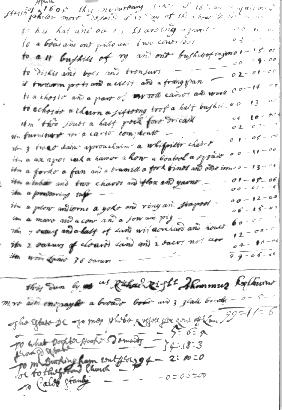Emerging from the Shadows, 1775-1819:
Free Blacks before the Revolutionary War |
|---|
Connecticut had a significant population of
Blacks who were free, but to some extent they shared
the disadvantages of their slave brethern. While a 1717 law passed by the Connecticut Legislature bared
any free Black or mulatto from residing in any own in the Connecticut colony and invalidated any land or
dwelling purchased by them, it is clear that free Blacks did come to live in certain towns and own property.
Manumitted slaves who were freed by their owner, perhaps as a reward for a life of dedicated service,
tended to maintain a personal and even subservient tie with their previous masters. So in towns where
there were slaves, there would constantly appear new free Blacks, often having personal ties within the
town.
The reason to discourage the settlement of free Blacks is not self-evident. This was well before
the notion of biological racism and with it the assumption that all Blacks were inherently inferior. The
prevailing thought in the colonial era was that all people share a common human nature, and any distinctions
among people were simply the result of some external cause such as political or geographic circumstance.
True, there was economic exploitation that correlated with a genetic trait (skin color), and this defines
racism, but most slaves in history up that that time had not been Black, but white or yellow. Being Black
was therefore not the cause of one's being a slave. Only later on, with "scientific" (biological) racism, did
one's skin color classify you as inherently inferior.
Perhaps the motive for the law was the danger that escaped slaves might find refuge or otherwise
disappear if there
was a free population of color to give them support. We are finding that the assimilation of early Blacks
in the New World proceeded rather more slowly than once assumed, and the bonds of shared African
language or homeland lasted for some time.
 However, these bonds that drew Blacks together, free and slave, were not very durable, and there
is little reason to suppose that skin color at the time could offer the basis for solidarity. On the other hand,
Blacks' lack of mobility probably slowed the formation of a common African-American culture. What is
more of concern here, though, is that solidarity was made difficult by the social mobility of a few Blacks,
often the more talented and ambitious, who stood to gain through their association with white society.
Land ownership and even becoming an elected official (as in one Farmington case) created the hope
that something more might be gained than through association with other Blacks.
However, these bonds that drew Blacks together, free and slave, were not very durable, and there
is little reason to suppose that skin color at the time could offer the basis for solidarity. On the other hand,
Blacks' lack of mobility probably slowed the formation of a common African-American culture. What is
more of concern here, though, is that solidarity was made difficult by the social mobility of a few Blacks,
often the more talented and ambitious, who stood to gain through their association with white society.
Land ownership and even becoming an elected official (as in one Farmington case) created the hope
that something more might be gained than through association with other Blacks.
Shown here is the probate court record of Philip Moore, 1695, archived in the Connecticut State Library.
Philip Moore was a free black who owned land in what is now East Hartford. The circumstances
of his owning that land are unknown, but it is evidence that at a very early date Blacks could in
fact become economically independent.
 This is a map of a portion of Hartford in 1790, made by Solomon Porter and now in the Connecticut
Historical Society Library. The top of the map shown here is toward the East, and so across the top runs
the Connecticut River. Heading west from the River (down on this map) was Coles Street, which
intersected with Lower Ferry Road, which in turn ran south until it became South Meadow Lane (off to the
lower right on this map). The intersection is now the corner of Charter Oak Avenue and Father Jerzy
Popieluszko Court.
This is a map of a portion of Hartford in 1790, made by Solomon Porter and now in the Connecticut
Historical Society Library. The top of the map shown here is toward the East, and so across the top runs
the Connecticut River. Heading west from the River (down on this map) was Coles Street, which
intersected with Lower Ferry Road, which in turn ran south until it became South Meadow Lane (off to the
lower right on this map). The intersection is now the corner of Charter Oak Avenue and Father Jerzy
Popieluszko Court.
At this intersection was a piece of land owned by James Nichols. When Nichols freed his slave
Boston, he gave him some land at the corner of his plot, and this is probably where on the map is
shown a house identified as "Negro House" (near the lower left of this picture and not far from Main
Street, today). While Boston maintained a physical proximity to his previous owner, he also began to
rise socially with the help of whites. Indeed, we will soon discover that this Boston ended up the Black
Governor of Hartford.
|

![[Exhibit contents]](../../bin/top.gif)
![[Back]](../../bin/back.gif)
![[Forward]](../../bin/forward.gif)
|